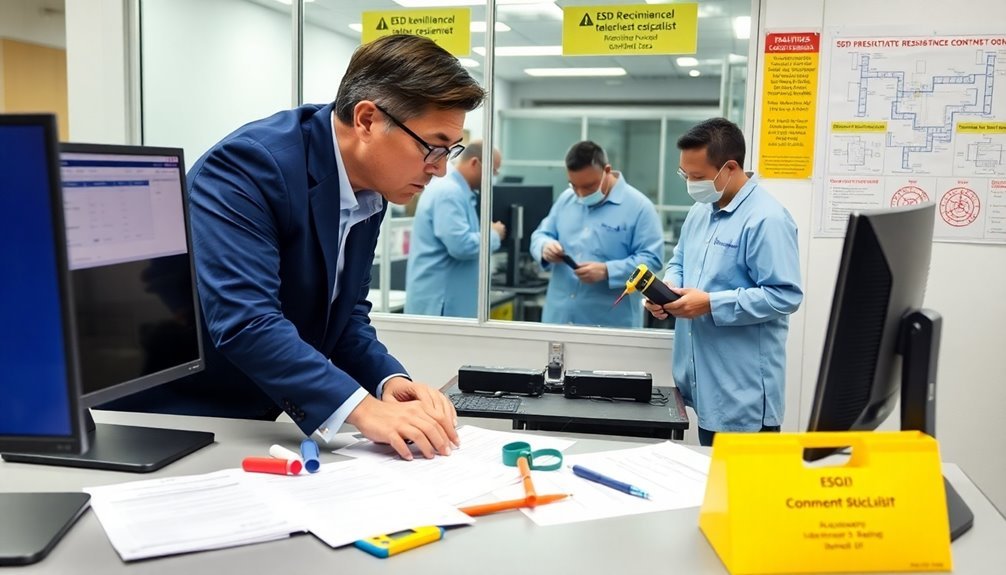As an ESD Program Coordinator, you'll focus on three essential duties to protect sensitive electronic components. First, you'll develop and implement extensive ESD control procedures that align with ANSI/ESD S20.20 and IEC 61340-5-1 standards. Second, you'll conduct regular compliance monitoring and auditing to verify all departments follow established protocols, making corrections when needed. Third, you'll provide thorough training and technical support to staff, confirming everyone understands proper ESD control measures. These fundamental responsibilities form the foundation of effective ESD management, but there's much more to explore about this critical role.
Program Development and Implementation

When developing an ESD program, you'll need to create thorough documentation that protects ESD-sensitive items while meeting ANSI/ESD S20.20 or IEC 61340-5-1 standards. You must prepare written procedures and specifications that clearly outline the scope, tasks, and activities for ESD control, then distribute these to all departments to guarantee consistent implementation.
Your implementation plan should consider manufacturing environments, including self-directed work teams, while establishing clear individual responsibilities and deadlines. The plan should include facility surveys and assessments to properly measure resistance ranges and electrostatic fields. You'll need to track progress and include all relevant parties in your plan, from suppliers to original equipment manufacturers.
Make sure you build your implementation strategy around critical success factors, particularly management commitment and realistic requirements.
As the ESD coordinator, you'll serve as your company's internal consultant for all ESD control areas. You must develop budgets, administer the program, and report directly to management on all site ESD matters.
You'll coordinate with both internal and external stakeholders to meet program objectives, while continuously developing strategies to improve efficiency and effectiveness. Remember to maintain regular communication about program activities and results to guarantee ongoing success.
Compliance Monitoring and Auditing
Effective compliance monitoring forms the backbone of a successful ESD control program. As an ESD Program Coordinator, you'll need to implement regular audits across three key areas: program management, quality process checking, and ESD Control Program compliance verification.
You'll conduct sampling based on experience and findings, adjusting the frequency according to conformance levels. You'll need to demonstrate return on investment through documented cost savings from your audit findings.
You're responsible for using detailed checklists and maintaining consistency in your auditing approach. You'll need to guarantee proper test equipment is available for EPA compliance verification and coordinate the sampling of work areas in each department.
When deficiencies are found, you'll implement and track corrective actions, which may include retraining personnel, revising documents, or modifying facilities.
Your duties include maintaining detailed records and preparing reports for management review. You'll need to track trends using charts and documentation to establish effective corrective measures.
It's vital that you verify staff competence before audits begin and coordinate with other investigative units when necessary. Remember to safeguard all audit documentation and guarantee data integrity throughout the process, as these records are essential for regulatory compliance.
Training and Technical Support

Building on the audit process, your role as an ESD Program Coordinator extends into thorough training and technical support responsibilities. You'll need to develop extensive training materials that align with IEC 61340 guidelines while verifying they're easily understood by various audiences.
Your training delivery should be versatile, utilizing in-person sessions, virtual meetings, and other communication channels to reach all staff effectively. Working for Sanmina Corporation means implementing these training programs across global manufacturing facilities.
As the company's internal ESD consultant, you'll serve as the primary point of contact for all ESD-related inquiries. This means you'll need to provide technical expertise, assist with process implementation, and coordinate with stakeholders to meet program objectives.
When issues arise, you're responsible for escalating them to appropriate departments and following up to verify resolution.
Your technical support duties also include identifying training needs based on common questions and trends. You'll develop targeted training programs to address these gaps and implement strategies to enhance training efficiency.
Throughout all these activities, you'll verify that ESD protection measures are properly understood and followed, while providing ongoing support to reinforce learning and maintain program effectiveness.
Frequently Asked Questions
How Often Should ESD Protective Equipment Be Replaced or Recalibrated?
You'll need to check wrist straps daily in high-risk areas, replace anti-static shoes every 3 months, and test other ESD equipment based on your specific risk assessment and documented control plan requirements.
What Are the Cost Implications of Implementing a Facility-Wide ESD Program?
You'll need to invest greatly upfront, but you can expect ROIs of 900-2300%. While initial costs include training and equipment, you'll save millions through reduced failures and repairs over time.
Can Remote Workers Be Effectively Integrated Into an ESD Control Program?
Yes, you can effectively integrate remote workers into your ESD program through virtual training, remote workspace certification, and online monitoring. You'll need proper documentation, regular video inspections, and clear communication channels.
How Do Seasonal Changes Affect ESD Control Measures and Monitoring?
You'll need to monitor ESD controls more closely during dry seasons, as lower humidity reduces static dissipation. Adjust your testing frequency and verify equipment performance when seasonal changes cause significant humidity drops.
What Insurance Considerations Are Necessary for Esd-Related Equipment and Procedures?
You'll need specialized insurance that covers ESD damage, including repair-or-replacement coverage. Verify your plan includes protection for sensitive equipment, compliance verification, and maintenance services. Don't forget to think about certification requirements.
In Summary
As an ESD Program Coordinator, you've got essential responsibilities that directly impact your organization's electrostatic discharge control. You'll need to stay focused on developing robust programs, conducting thorough compliance monitoring, and delivering effective training. By mastering these three key duties, you're not just protecting sensitive electronic components – you're ensuring your company's quality standards and operational success.





Leave a Reply